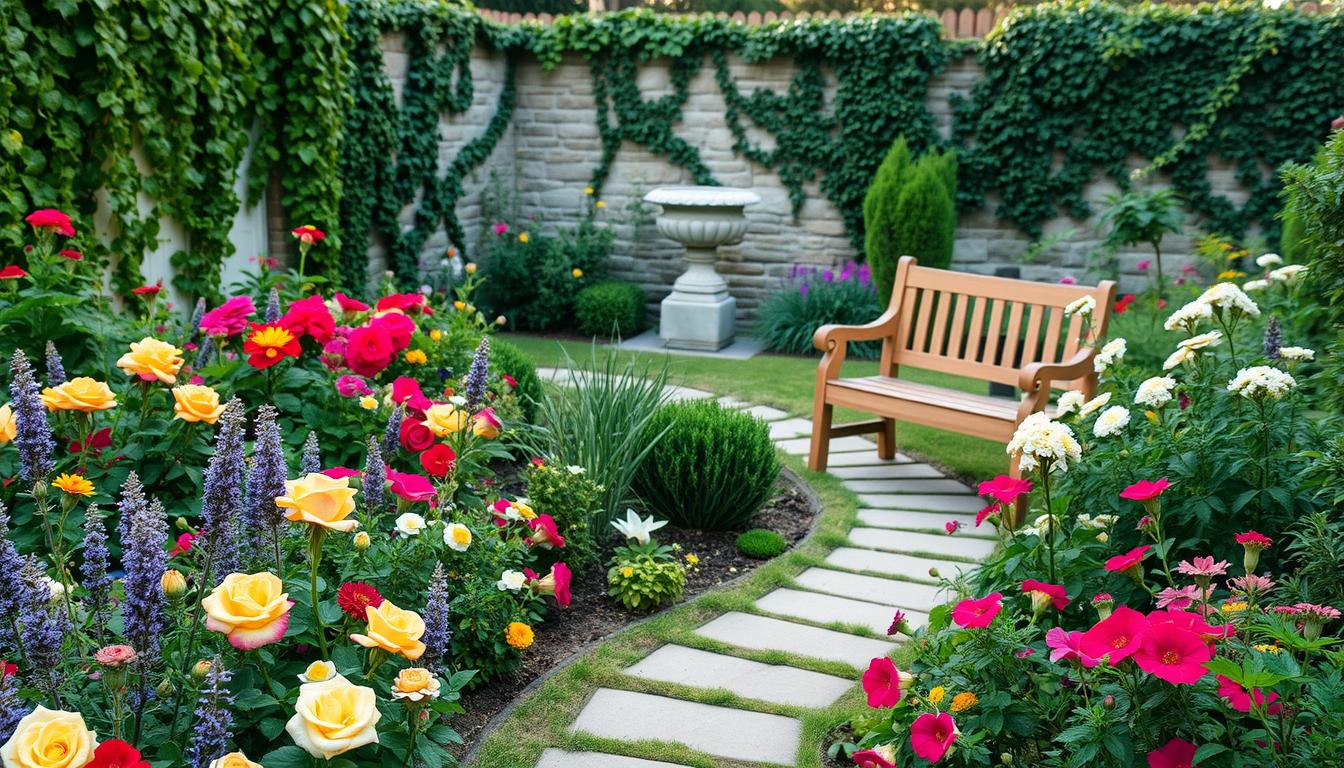
Small Garden Design
Can you turn a small, cramped backyard into a stunning oasis? Yes, with the right design ideas, even tiny spaces can become beautiful retreats. Whether it’s a small urban patio or a modest suburban yard, careful planning and creativity can make a big difference.
Small backyard landscaping doesn’t have to be dull. By using simple garden ideas and smart outdoor patio concepts, you can make your space feel bigger. Try vertical gardening, container planting, multifunctional furniture, and strategic lighting to enhance your small garden.
In this article, we’ll dive into the key principles for making compact outdoor spaces stunning. You’ll learn how to unlock your small garden’s full beauty and create a space you’ll love spending time in.
Assess Your Available Space and Set Goals
Starting a small garden layout project begins with checking your space. Measure and analyze your garden area carefully. Note any special features, limits, or chances that might shape your design.
- Total square footage
- Sun exposure and shade patterns
- Existing structures or obstacles
- Soil quality and drainage
- Privacy concerns
| Garden Size | Recommended Elements |
|---|---|
| Less than 100 sq ft | Container gardens, vertical gardens, seating nook |
| 100-300 sq ft | Small patio, compact furniture, raised beds |
| 300-500 sq ft | Distinct zones, water feature, small lawn area |
Measure and Analyze Your Garden Area
Getting precise measurements is key for a good small garden layout. Use a tape measure or laser tool to find your space’s length and width. Also, remember any odd shapes or height changes that might change your design.
Determine Your Garden’s Purpose and Style
Think about what you want your garden to be. Do you want a calm spot for rest, a lively area for parties, or a place to grow food? Knowing your goal helps pick plants, materials, and layout.
Also, think about the style you like. Small garden inspiration is everywhere, from modern to cottage gardens. Look at magazines, websites, and social media to find a style that fits your home and tastes.
By carefully looking at your space, setting goals, and picking a style, you’re ready to start a great small courtyard garden makeover.
Create a Functional Layout
Designing a small garden means focusing on a functional layout. This ensures your space is both useful and enjoyable. With the right plan, even the smallest backyard can become a beautiful retreat.
Divide Your Garden into Zones
Divide your garden into zones for different uses. You might have areas for sitting, dining, and plants. This strategy makes the most of your space and adds order to your garden.
| Zone | Purpose | Examples |
|---|---|---|
| Seating Area | Relaxation and enjoyment | Bench, lounge chairs, hammock |
| Dining Spot | Outdoor meals and entertaining | Bistro table and chairs, picnic table |
| Planting Beds | Greenery and visual interest | Flower borders, vegetable patches, herb gardens |
Plan for Circulation and Pathways
Good circulation and pathways are key in small garden plans. They help you move around and make your garden seem bigger. Use curved or zigzag paths to add beauty and make the most of your space.
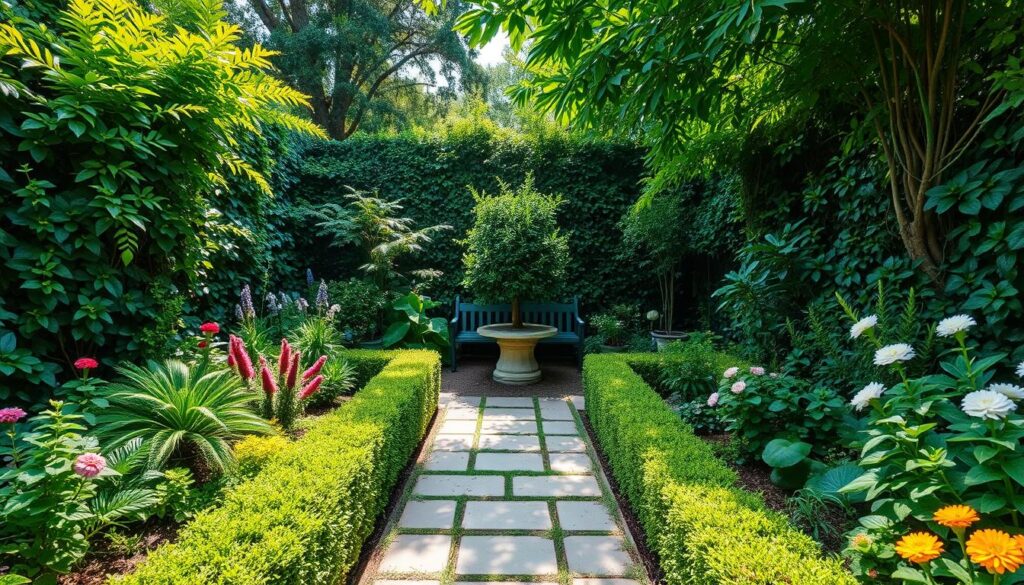
Consider Vertical Gardening Solutions
Vertical gardening is a great idea for small backyard ideas. It lets you grow more plants without taking up floor space. Use trellises, climbing plants, or hanging baskets to add depth and make the most of your vertical space.
Choose the Right Plants for Your Small Garden
When it comes to small space gardening, picking the right plants is key. You want a garden that looks great and grows well. Choose plants that are small and have interest all year. This way, your garden will be beautiful and full of life.

Opt for Compact and Dwarf Varieties
To use your space wisely, pick compact and dwarf plants. These smaller versions of popular plants are just as pretty but won’t take over. Here are some great choices:
- Dwarf conifers, such as ‘Nana’ hinoki cypress or ‘Tom Thumb’ Japanese white pine
- Compact shrubs, like ‘Tiny Tuff Stuff’ hydrangea or ‘Minuet’ weigela
- Miniature roses, such as ‘Rainbow’s End’ or ‘Cupcake’
Select Plants with Multiple Seasons of Interest
For a garden that’s interesting all year, choose plants that bloom and look good for months. Plants with long-lasting flowers, pretty leaves, or striking bark are perfect. Here are some ideas for your garden design ideas:
- Evergreen shrubs, like boxwood or holly, for consistent structure and color
- Perennials with long-lasting blooms, such as coneflowers or catmint
- Trees with ornamental bark, like paperbark maple or river birch
- Plants with attractive fall foliage, such as Japanese maples or blueberry bushes
By picking the right plants, you can make a beautiful and varied garden. Your small space will be full of life and interest all year.
Incorporate Hardscaping Elements
When designing a small garden, hardscaping elements are key. They define spaces, add visual interest, and boost functionality. Choosing the right paving materials for small gardens greatly impacts your outdoor space’s look and feel.
Here are some small garden hardscaping elements to consider:
- Paved pathways or stepping stones to guide foot traffic and create distinct zones
- Retaining walls to define borders, create level changes, and provide additional seating
- Vertical structures like trellises, arbors, or pergolas to add height and support climbing plants
- Built-in seating or raised planters to maximize space and functionality
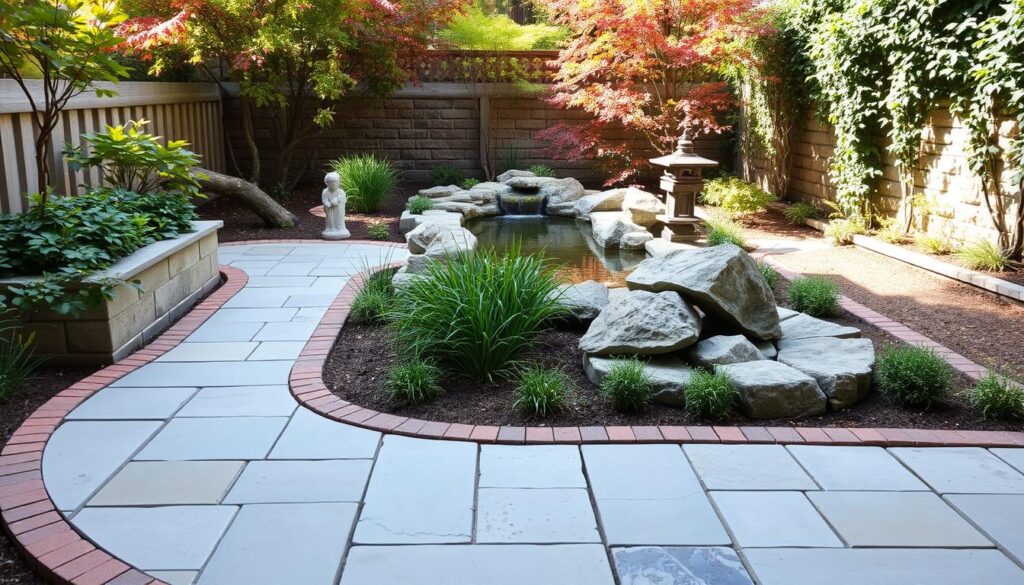
When picking paving materials, choose ones that match your garden’s scale and style. Here are some top picks for small garden structures and paving:
| Material | Pros | Cons |
|---|---|---|
| Brick | Durable, classic look, easy to install | Can be expensive, may require regular maintenance |
| Concrete Pavers | Affordable, wide range of colors and patterns | May lack the natural look of stone or brick |
| Natural Stone | Unique, durable, complements organic landscapes | Expensive, may require professional installation |
| Gravel | Budget-friendly, easy to install, permeable | Can be difficult to walk on, may require edging to contain |
By carefully choosing hardscaping elements and paving materials, you can turn your small garden into a beautiful and useful outdoor space.
Utilize Creative Container Gardening
Container gardening is great for small gardens, making them look amazing. It lets you use your outdoor space in new ways. With the right containers and planning, your garden can be both beautiful and personal.
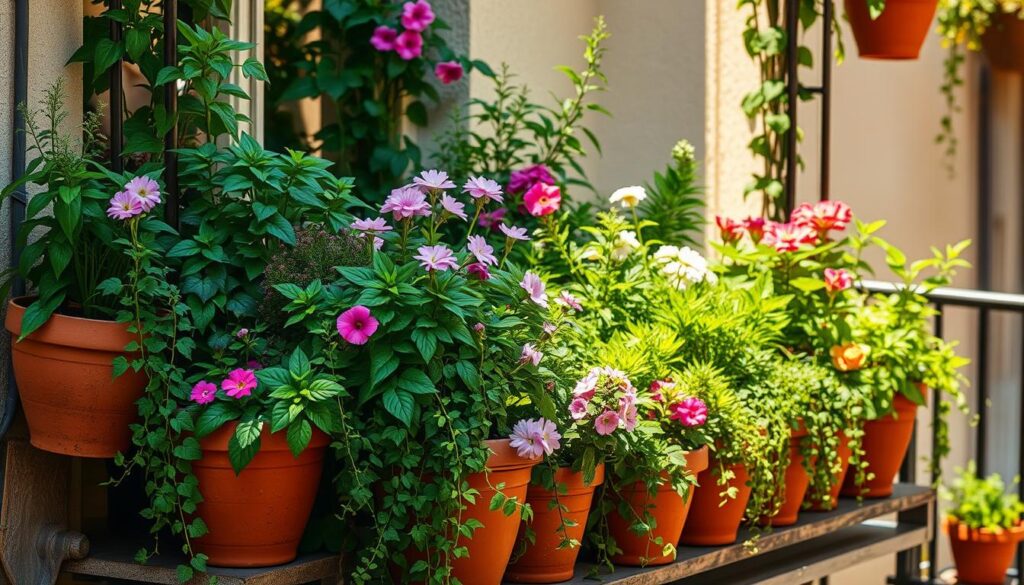
Select Appropriate Containers for Your Space
Choosing the right containers is key for small space container gardening. Think about size, material, and style that fit your garden. You can pick from modern to rustic, depending on what you like.
Make sure your containers have holes for water to drain. Also, think about how heavy they are. This is important if you move them around or bring them inside.
Experiment with Container Arrangements
Container garden design lets you try out different looks. Mix up the heights, colors, and textures of your containers. This adds depth and interest to your garden.
Use vertical space by stacking or hanging baskets. Try out thriller-filler-spiller plants for a lively look. This way, your garden will be full of life and color.
Optimize Seating Areas and Outdoor Living Spaces
When designing your small garden, it’s key to use your space wisely. Create cozy seating areas and inviting outdoor spaces. With smart planning and small garden seating ideas, your garden can become a cozy oasis.
Integrate Multifunctional Furniture
For outdoor living in small spaces, choose furniture that does more than one thing. Look for benches with storage or tables that fold up. Here’s a table of some great options:
| Furniture Type | Functions | Benefits |
|---|---|---|
| Storage Bench | Seating, Storage | Saves space, keeps garden tidy |
| Folding Table | Dining, Workspace | Easily stored when not in use |
| Stackable Chairs | Seating | Compact storage, flexible arrangements |
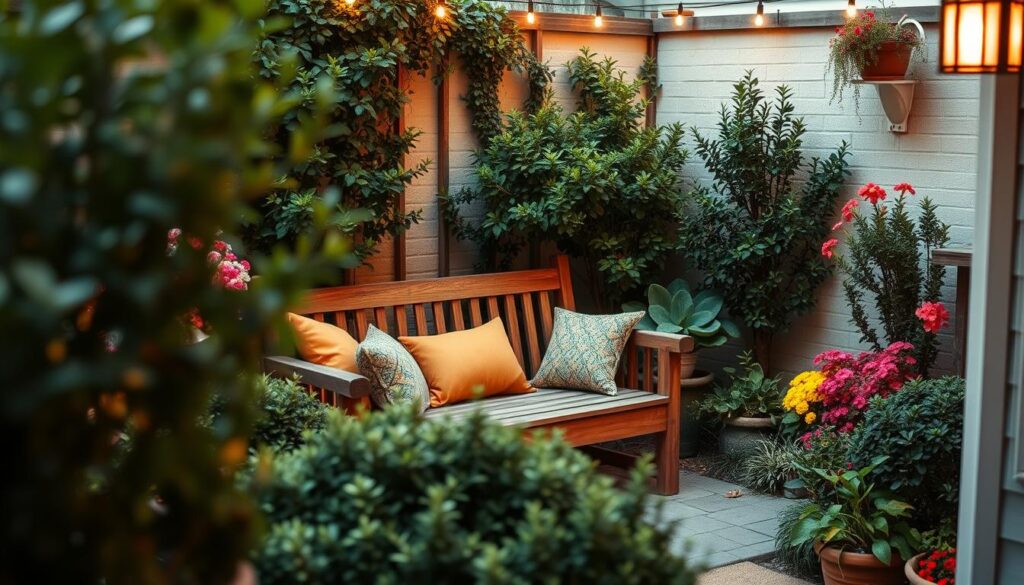
Create Cozy Nooks and Intimate Gatherings
To make your garden cozy, focus on creating snug spots. Place seating in corners or by garden beds. Use cushions and throws to add comfort and style to your small garden furniture.
When planning outdoor living in small spaces, think about how people will move. Place seating away from paths for privacy. By designing with seating in mind, you’ll make the most of your space for relaxation.
Enhance Your Garden with Lighting and Accessories
Turn your small garden into a magical place with small garden lighting ideas and the right accessories. Good lighting makes your garden welcoming, even at night. Try string lights on fences, solar lanterns among plants, or spotlights on key spots.
Garden accessories for small spaces can make your garden unique and stylish. Choose items that are both beautiful and useful, like a bird bath that’s also a centerpiece. A colorful rug can mark a seating area. Use wall planters, hanging baskets, and vertical gardens to save space.
When picking accessories, think about your garden’s theme and colors. A consistent look makes your garden look better. Mix textures and patterns to add depth. But remember, in a small garden, less is more. Choose carefully to avoid clutter.
| Lighting Ideas | Decorative Accessories |
|---|---|
| String lights | Sculptural bird bath |
| Solar lanterns | Colorful outdoor rug |
| Spotlights | Wall-mounted planters |
| Path lights | Hanging baskets |
With the right lighting and accessories, your small garden will become a beautiful and functional space. It will be a place you’ll love to be in, day or night.
Embrace Low-Maintenance Landscaping Techniques
Creating a stunning small garden doesn’t mean endless hours of maintenance. By using low-maintenance landscaping, you can enjoy your outdoor space with less effort. With smart choices, your garden can thrive with minimal care.
Choose Easy-Care Plants and Materials
Choosing plants that need little care is key. Pick native species that fit your local climate and soil. These plants often need less water, food, and pruning than others.
For plants, think about succulents, ornamental grasses, and hardy perennials. They can do well with little help. For materials, pick durable and easy-to-care-for options. Use permeable pavers or gravel for paths and patios to help water drain.
For decking, consider composite or PVC. They last longer and need less care than wood.
Implement Water-Wise Gardening Practices
Water-saving techniques are vital for small gardens. Mulching helps keep soil moist, stops weeds, and keeps soil temperature right. Use organic mulch like bark chips or straw around your plants.
Think about getting a drip irrigation system. It waters plants right at the roots, saving water. Group plants by water needs to avoid over or underwatering. Also, use rain barrels or permeable surfaces to catch and use rainwater.
By using low-maintenance landscaping and choosing easy plants, you can have a beautiful garden with little effort. Save water, pick durable materials, and choose plants that need less care. This way, you can enjoy your garden more without the hassle.
Small Garden Design Inspiration and Ideas
Looking for inspiring small garden transformations? Check out our small garden design gallery. It’s full of creative ideas to spark your imagination. You’ll see everything from clever vertical gardening to stunning plant combinations.
Discover designs that make the most of every inch. See how people use multifunctional furniture and space-saving features. You’ll find ideas for both modern and cottage-inspired gardens.
As you look through the gallery, think about how you can make these ideas your own. With a bit of creativity and planning, you can turn your small garden into a beautiful oasis. Get ready to be inspired and start making your dream garden a reality!
Leave a Reply